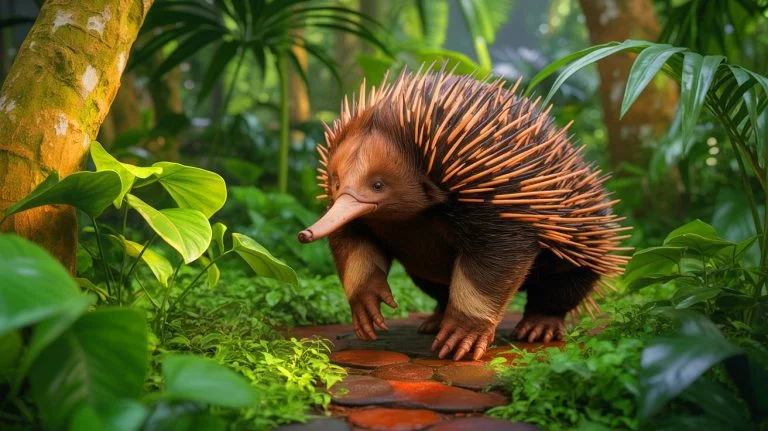| IN A NUTSHELL |
|
In an extraordinary turn of events, scientists have confirmed the rediscovery of the Attenborough’s long-beaked echidna, a species thought to be extinct for over six decades. This remarkable find was made deep in the Indonesian rainforests, reviving hopes for the survival of this ancient species. Named after the legendary naturalist David Attenborough, this species is one of the Earth’s few egg-laying mammals, known for its spiky fur and distinctive beak. Often called “living fossils,” echidnas have an ancient lineage, believed to have originated around 200 million years ago during the era of dinosaurs. The photographic evidence of this elusive creature has been a breakthrough in the scientific community, shedding light on the biodiversity hidden within the depths of our planet’s rainforests.
Finding Elusive Echidna
The rediscovery of the long-beaked echidna, known scientifically as Zaglossus attenboroughi, marks a significant milestone in wildlife conservation. The species had not been recorded in over 60 years, with the last known observation being a dead specimen now housed in the Treasure Room of the Naturalis Museum in the Netherlands. In 2023, an expedition from Oxford University to the remote Cyclops Mountains, located 6,561 feet above sea level, provided the first glimmer of hope. During this expedition, researchers deployed modern scientific techniques, including camera-trapping, and set up 73 camera traps across a 2.7 square mile area. These traps were strategically placed along animal trails and ridgelines, where potential echidna “nose-pokes” were found — these are holes created by echidnas while foraging for invertebrates underground.
Local indigenous knowledge played a crucial role in this discovery. Generations of local communities had reported sightings of the echidna, and their insights were invaluable in guiding the search. The combined efforts of modern science and traditional knowledge culminated in the capture of 110 photographs from 26 separate events, providing irrefutable proof that Attenborough’s long-beaked echidna is alive and thriving in the Cyclops Mountains. This rediscovery not only highlights the importance of indigenous knowledge in scientific research but also emphasizes the significance of collaboration between local communities and scientists in preserving biodiversity.
Unique Evolutionary History
The long-beaked echidna is one of only five living species of egg-laying mammals, belonging to an ancient lineage called monotremes. These creatures diverged from other mammals over 200 million years ago, making them some of the planet’s most enigmatic “lost species.” The rediscovery of Zaglossus attenboroughi underscores the importance of conserving a unique evolutionary history that connects us to the distant past. Previously found in the Oenaka Range of Papua New Guinea, the Cyclops Mountains now serve as the only confirmed modern stronghold for this distinct species.
The significance of this discovery extends beyond the survival of a single species. It offers hope for the preservation of other “lost species” amidst a global biodiversity crisis. With more than 2,000 so-called lost species identified, some may indeed be extinct, yet rediscoveries like this prove that others survive, especially in regions where biological research has been limited. This find is a beacon of hope, encouraging further exploration and study of the world’s unexplored regions.
Conservation Efforts and Global Implications
The confirmation of the long-beaked echidna’s existence is a call to action for conservationists worldwide. Protecting this species and its habitat in the Indonesian rainforest is vital for maintaining biodiversity and ecological balance. The findings, published in the journal NPJ Biodiversity, highlight the need for heightened conservation efforts and increased awareness of the challenges faced by unique habitats.
Conservationists are now focused on creating strategies to safeguard the echidna’s environment from threats such as deforestation and habitat degradation. The international scientific community must collaborate with local governments and organizations to ensure the protection of this ancient species. This rediscovery also prompts a reevaluation of conservation priorities, urging policymakers to consider the ecological value of species that have been overlooked or presumed extinct.
The Role of Technology in Wildlife Discovery
The rediscovery of the long-beaked echidna underscores the transformative role of technology in wildlife conservation. The use of camera traps and other modern scientific methods has proven invaluable in documenting and monitoring elusive species. These technologies enable researchers to gather data in challenging environments, providing insights into the behaviors and habitats of species that are difficult to study through traditional means.
As technology continues to evolve, its application in wildlife research is likely to expand, offering new opportunities to explore and understand the natural world. This case highlights the potential for technological advancements to revolutionize conservation efforts, making it possible to rediscover and protect species that would otherwise remain hidden. The integration of technology with traditional knowledge and conservation strategies is essential for addressing the complex challenges posed by biodiversity loss in the 21st century.
The rediscovery of Attenborough’s long-beaked echidna serves as a powerful reminder of the mysteries that still lie hidden within our planet’s ecosystems. This finding raises important questions about how many other “lost species” might be waiting to be found and what steps we can take to protect these invaluable treasures. How can we continue to balance technological advancements with traditional knowledge to ensure the survival of our planet’s most extraordinary creatures?
Did you like it? 4.6/5 (23)







Wow, this is incredible! How did they manage to find it after so many years? 🤔
So cool that they named it after David Attenborough! He totally deserves it. 🌿
Is there any video footage of the echidna, or just photos?
Why did it take 62 years to find this creature again? What changed?
This is a great example of science and indigenous knowledge working together. Kudos to the team!
Do these echidnas face any immediate threats now that they’ve been found?
Why is it always the rainforest that has these amazing hidden species?
Nice article! I love reading about rediscovered species. Nature is full of surprises! 🌍
Can you imagine being the scientist who first saw the echidna on camera? Must have been mind-blowing!
This makes me wonder what other “extinct” animals are still out there waiting to be rediscovered…
I hope this doesn’t lead to poachers targeting the echidnas now that they’re back on the radar. 😟
Not sure I believe this. Seems too good to be true, doesn’t it?
Are there any conservation plans already in place to protect this echidna species?
Thanks for sharing this incredible news. It’s a reminder of the importance of conservation! 🙌
How do they know it’s the exact same species as the one from 62 years ago?
I’ve always been fascinated by monotremes. They are truly unique creatures.
Is this species unique to Indonesia, or can it be found elsewhere?
Great to see technology playing such an important role in wildlife conservation!
Does this mean we should be more optimistic about finding other lost species?
I wonder if there are any plans to study the echidna’s habitat more closely now.
Why did they stop looking after the first one was found dead? Seems like a missed opportunity.
Hope this leads to more funding for rainforest conservation projects. 🌱
Are there any unique behaviors that have been observed in this echidna species?
Weren’t there any signs of its existence all these years? Seems a bit odd.
This is why I love science—always full of surprises! 😄
Perhaps other “extinct” species are simply hiding in places we haven’t looked yet.
The combination of modern technology and traditional knowledge is really powerful in cases like these!
Can you imagine how old some of these echidnas might be? Living fossils indeed!
What an inspiring story! Hopefully, this encourages more young people to pursue wildlife research.